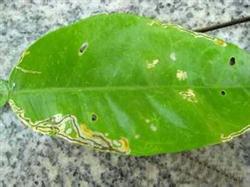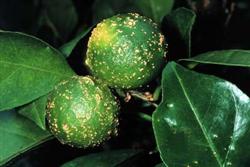Control of diseases and insect pests in citrus in summer and autumn

1. Whitefly: Both adults and larvae can harm citrus leaves and fruits, sucking juice with piercing mouthparts, secreting a large amount of honeydew to pollute leaves and fruits, causing bituminous coal disease. Because whitefly reproduces fast, hosts many and spreads easily, it needs to adopt large area joint control to get good effect. (1) Control time: When there are more than 5 insects per tender leaf on average, control should be carried out. (2) Control chemicals: 5% acetamiprid 1500 times, 2.5% chlorofluorocarbon 2000-2500 times liquid spray. 2, arrowhead scale: serious occurrence can cause litter, yellow-green spots formed on the peel and insects attached to it, affecting the appearance and quality of the fruit. The first generation nymph peak period is in the middle and late May, the second generation is in the middle and late July, the third generation is in the middle and late September. The third generation mainly damages the upper part and fruit of orange trees. The development of the first generation nymph is relatively regular, which is the key to chemical control throughout the year. The second and third generations should be controlled by selective treatment because of their long occurrence time and overlapping generations. (1) Control time: mid-late July and mid-late September. (2) Control chemicals: 40% chlorpyrifos 1200 times, 40% fluprofos 1200 times liquid spray. 3. Citrus leaf miner: larvae sneak into the epidermis of young leaves to feed, and they become irregular silver-white tunnels, resulting in abnormal curling of leaves, seriously affecting photosynthesis. Citrus canker bacteria are easy to invade leaf wounds, and occur most frequently in summer and autumn. The comprehensive control measures of "wiping bud and controlling shoot, spraying timely to protect shoot" can be adopted. The principle of wiping bud and controlling shoot is to remove early and keep it neat, remove zero and keep it whole, so as to make the shoot consistent, which is beneficial to spraying and protecting shoot and shortening control time. The pesticide can be sprayed with 20% Chinese pyrethroid 4000 times solution and 2.5% Encide 3000 times solution. When using drugs to protect shoots, attention must be paid to: (1) combined with bud control;(2) spray protection on bud length "one grain of rice";(3) rotation of chemicals;(4) serious prevention and control once every 4-5 days, continuous prevention and control. 4. Citrus anthracnose: It mainly damages tender leaves, tender shoots, fruit stems and fruits, and can cause deciduous leaves, dead branches, fruit drop, fruit rot, etc. The disease is a fungal disease, generally in high temperature and humid climate conditions easy to occur, summer and autumn high temperature and rain favorable incidence. Especially in September and October, the high temperature and humidity are conducive to the occurrence of fruit stalk anthracnose and cause a large number of fruit drops. (1) Control time: late September and late October. (2) Control chemicals: 25% prochloraz manganese salt 600 times, 80% Dasheng M-45 sexual powder 600 times liquid spray.
- Prev

Symptoms and Preventive measures of Fertilizer injury in Citrus Orchard
From the beginning of May to the end of June, it is the critical period from flowering to stable fruit of citrus. In citrus production, this period is usually called young fruit stage. In the meantime, citrus will go through two important physiological fruit drop stages: the first physiological fruit drop and the second physiological fruit drop. The quality of the culture tube in this period often directly affects the yield of the year and the appearance of the fruit.
- Next

Planting method of Snake skin Fruit
Planting method of Snake skin Fruit
Related
- Moge, come on! The staff of the peasant association in the producing area of cantaloupe were frightened when the crowd gathered.
- Causes and Solutions of low Fruit setting rate of Apple
- Symptoms and control measures of passion fruit virus disease
- Fruit growing lesson: how do apple orchards keep high yields?
- Can you build orchards in the mountains? What are the pros and cons?
- How to manage the coloring period of Crisson grape?
- This paper introduces the processing technology of two kinds of fig products.
- How much is a month for retired teachers in rural areas by 2020?
- How can strawberry planting increase sugar content? We should pay attention to management in many aspects.
- What are the cultivation techniques on how to improve the yield of golden fruit?

